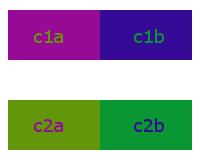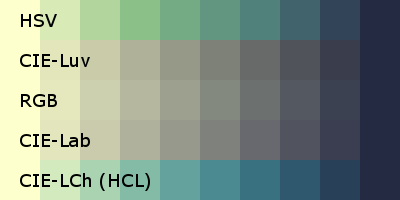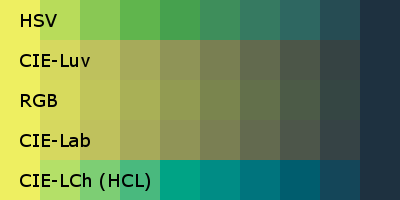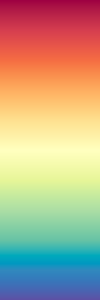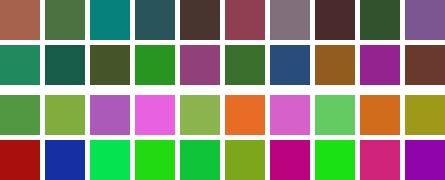A library for playing with colors in go (golang).
I love games. I make games. I love detail and I get lost in detail. One such detail popped up during the development of Memory Which Does Not Suck, when we wanted the server to assign the players random colors. Sometimes two players got very similar colors, which bugged me. The very same evening, I want hue was the top post on HackerNews' frontpage and showed me how to Do It Right (tm). Last but not least, there was no library for handling color spaces available in go. Colorful does just that and implements Go's color.Color interface.
Go-Colorful stores colors in RGB and provides methods from converting these to various color-spaces. Currently supported colorspaces are:
- RGB: All three of Red, Green and Blue in [0..1].
- HSV: Hue in [0..360], Saturation and Value in [0..1]. You probably shouldn't use this.
- Hex RGB: The "internet" color format, as in #FF00FF.
- Linear RGB: See gamma correct rendering.
- CIE-XYZ: CIE's standard color space, almost in [0..1].
- CIE-xyY: encodes chromacity in x and y and luminance in Y, all in [0..1]
- CIE-L*a*b*: A perceptually uniform color space, i.e. distances are meaningful. L* in [0..1] and a*, b* almost in [-1..1].
- CIE-L*u*v*: Very similar to CIE-L*a*b*, there is no consensus on which one is "better".
- CIE-L*C*h° (HCL): This is generally the most useful one; CIE-L*a*b* space in polar coordinates, i.e. a better HSV. H° is in [0..360], C* almost in [-1..1] and L* as in CIE-L*a*b*.
For the colorspaces where it makes sense (XYZ, Lab, Luv, HCl), the D65 is used as reference white by default but methods for using your own reference white are provided.
A coordinate being almost in a range means that generally it is, but for very bright colors and depending on the reference white, it might overflow this range slightly. For example, C* of #0000ff is 1.338.
Unit-tests are provided.
- Converting color spaces. Some people like to do that.
- Blending (interpolating) between colors in a "natural" look by using the right colorspace.
- Generating random colors under some constraints (e.g. colors of the same shade, or shades of one color.)
- Generating gorgeous random palettes with distinct colors of a same temperature.
There are a few features which are currently missing and might be useful. I just haven't implemented them yet because I didn't have the need for it. Pull requests welcome.
- Functions for computing distances in various spaces. Note that this seems to be a whole science on its own.
- Sorting colors (potentially using above mentioned distances)
It depends on what you want to do. I think the folks from I want hue are on-spot when they say that RGB fits to how screens produce color, CIE L*a*b* fits how humans perceive color and HCL fits how humans think colors.
Whenever you'd use HSV, rather go for CIE-L*C*h°. for fixed lightness L* and chroma C* values, the hue angle h° rotates through colors of the same perceived brightness and intensity.
Installing the library is as easy as
$ go get github.com/lucasb-eyer/go-colorfulThe package can then be used through an
import "github.com/lucasb-eyer/go-colorful"Create a beautiful blue color using different source space:
// Any of the following should be the same
c := colorful.Color{0.313725, 0.478431, 0.721569}
c := colorful.Hex("#517AB8")
c := colorful.Hsv(216.0, 0.56, 0.722)
c := colorful.Xyz(0.189165, 0.190837, 0.480248)
c := colorful.Xyy(0.219895, 0.221839, 0.190837)
c := colorful.Lab(0.507850, 0.040585,-0.370945)
c := colorful.Luv(0.507849,-0.194172,-0.567924)
c := colorful.Hcl(276.2440, 0.373160, 0.507849)
Printf("RGB values: %v, %v, %v", c.R, c.G, c.B)And then converting this color back into various color spaces:
hex := c.Hex()
h, s, v := c.Hsv()
x, y, z := c.Xyz()
x, y, Y := c.Xyy()
l, a, b := c.Lab()
l, u, v := c.Luv()
h, c, l := c.Hcl()Note that, because of Go's unfortunate choice of requiring an initial uppercase, the name of the functions relating to the xyY space are just off. If you have any good suggestion, please open an issue. (I don't consider XyY good.)
In the RGB color space, the Euclidian distance between colors doesn't correspond to visual/perceptual distance. This means that two pairs of colors which have the same distance in RGB space can look much further apart. This is fixed by the CIE-L*a*b*, CIE-L*u*v* and CIE-L*C*h° color spaces. Thus you should only compare colors in any of these space. (Note that the distance in CIE-L*a*b* and CIE-L*C*h° are the same, since it's the same space but in cylindrical coordinates)
The two colors shown on the top look much more different than the two shown on
the bottom. Still, in RGB space, their distance is the same.
Here is a little example program which shows the distances between the top two
and bottom two colors in RGB, CIE-L*a*b* and CIE-L*u*v* space. You can find it in doc/colordist.go.
package main
import "fmt"
import "github.com/lucasb-eyer/go-colorful"
func main() {
c1a := colorful.Color{150.0/255.0, 10.0/255.0, 150.0/255.0}
c1b := colorful.Color{ 53.0/255.0, 10.0/255.0, 150.0/255.0}
c2a := colorful.Color{10.0/255.0, 150.0/255.0, 50.0/255.0}
c2b := colorful.Color{99.9/255.0, 150.0/255.0, 10.0/255.0}
fmt.Printf("DistanceRgb: c1: %v and c2: %v\n", c1a.DistanceRgb(c1b), c2a.DistanceRgb(c2b))
fmt.Printf("DistanceLab: c1: %v and c2: %v\n", c1a.DistanceLab(c1b), c2a.DistanceLab(c2b))
fmt.Printf("DistanceLuv: c1: %v and c2: %v\n", c1a.DistanceLuv(c1b), c2a.DistanceLuv(c2b))
}Running the above program shows that you should always prefer any of the CIE distances:
$ go run colordist.go
DistanceRgb: c1: 0.3803921568627451 and c2: 0.3858713931171159
DistanceLab: c1: 0.32048907700713997 and c2: 0.24397304315853596
DistanceLuv: c1: 0.513456934258258 and c2: 0.2568727826318425Note that AlmostEqualRgb is provided mainly for (unit-)testing purposes. Use
it only if you really know what you're doing. It will eat your cat.
Blending is highly connected to distance, since it basically "walks through" the colorspace thus, if the colorspace maps distances well, the walk is "smooth".
Colorful comes with blending functions in RGB, HSV and any of the LAB spaces.
Of course, you'd rather want to use the blending functions of the LAB spaces since
these spaces map distances well but, just in case, here is an example showing
you how the blendings (#fdffcc to #242a42) are done in the various spaces:
What you see is that HSV is really bad: it adds some green, which is not present in the original colors at all! RGB is much better, but it stays light a little too long. LUV and LAB both hit the right lightness but LAB has a little more color. HCL works in the same vein as HSV (both cylindrical interpolations) but it does it right in that there is no green appearing and the lighthness changes in a linear manner.
While this seems all good, you need to know one thing: When interpolating in any
of the CIE color spaces, you might get invalid RGB colors! This is important if
the starting and ending colors are user-input or random. An example of where this
happens is when blending between #eeef61 and #1e3140:
You can test whether a color is a valid RGB color by calling the IsValid method
and indeed, calling IsValid will return false for the redish colors on the bottom.
One way to "fix" this is to get a valid color close to the invalid one by calling
Clamped, which always returns a nearby valid color. Doing this, we get the
following result, which is satisfactory:
The following is the code creating the above three images; it can be found in doc/colorblend.go
package main
import "fmt"
import "github.com/lucasb-eyer/go-colorful"
import "image"
import "image/draw"
import "image/png"
import "os"
func main() {
blocks := 10
blockw := 40
img := image.NewRGBA(image.Rect(0,0,blocks*blockw,200))
c1, _ := colorful.Hex("#fdffcc")
c2, _ := colorful.Hex("#242a42")
// Use these colors to get invalid RGB in the gradient.
//c1, _ := colorful.Hex("#EEEF61")
//c2, _ := colorful.Hex("#1E3140")
for i := 0 ; i < blocks ; i++ {
draw.Draw(img, image.Rect(i*blockw, 0,(i+1)*blockw, 40), &image.Uniform{c1.BlendHsv(c2, float64(i)/float64(blocks-1))}, image.ZP, draw.Src)
draw.Draw(img, image.Rect(i*blockw, 40,(i+1)*blockw, 80), &image.Uniform{c1.BlendLuv(c2, float64(i)/float64(blocks-1))}, image.ZP, draw.Src)
draw.Draw(img, image.Rect(i*blockw, 80,(i+1)*blockw,120), &image.Uniform{c1.BlendRgb(c2, float64(i)/float64(blocks-1))}, image.ZP, draw.Src)
draw.Draw(img, image.Rect(i*blockw,120,(i+1)*blockw,160), &image.Uniform{c1.BlendLab(c2, float64(i)/float64(blocks-1))}, image.ZP, draw.Src)
draw.Draw(img, image.Rect(i*blockw,160,(i+1)*blockw,200), &image.Uniform{c1.BlendHcl(c2, float64(i)/float64(blocks-1))}, image.ZP, draw.Src)
// This can be used to "fix" invalid colors in the gradient.
//draw.Draw(img, image.Rect(i*blockw,160,(i+1)*blockw,200), &image.Uniform{c1.BlendHcl(c2, float64(i)/float64(blocks-1)).Clamped()}, image.ZP, draw.Src)
}
toimg, err := os.Create("colorblend.png")
if err != nil {
fmt.Printf("Error: %v", err)
return
}
defer toimg.Close()
png.Encode(toimg, img)
}A very common reason to blend colors is creating gradients. There is an example program in doc/gradientgen.go; it doesn't use any API which hasn't been used in the previous example code, so I won't bother pasting the code in here. Just look at that gorgeous gradient it generated in HCL space:
It is sometimes necessary to generate random colors. You could simply do this on your own by generating colors with random values. By restricting the random values to a range smaller than [0..1] and using a space such as CIE-H*C*l° or HSV, you can generate both random shades of a color or random colors of a lightness:
random_blue := colorful.Hcl(180.0+rand.Float64()*50.0, 0.2+rand.Float64()*0.8, 0.3+rand.Float64()*0.7)
random_dark := colorful.Hcl(rand.Float64()*360.0, rand.Float64(), rand.Float64()*0.4)
random_light := colorful.Hcl(rand.Float64()*360.0, rand.Float64(), 0.6+rand.Float64()*0.4)Since getting random "warm" and "happy" colors is quite a common task, there are some helper functions:
colorful.WarmColor()
colorful.HappyColor()
colorful.FastWarmColor()
colorful.FastHappyColor()The ones prefixed by Fast are faster but less coherent since they use the HSV
space as opposed to the regular ones which use CIE-L*C*h° space. The
following picture shows the warm colors in the top two rows and happy colors
in the bottom two rows. Within these, the first is the regular one and the
second is the fast one.
Don't forget to initialize the random seed! You can see the code used for
generating this picture in doc/golorgens.go.
As soon as you need to generate more than one random color, you probably want them to be distinguishible. Playing against an opponent which has almost the same blue as I do is not fun. This is where random palettes can help.
These palettes are generated using an algorithm which ensures that all colors
on the palette are as distinguishible as possible. Again, there is a Fast
method which works in HSV and is less perceptually uniform and a non-Fast
method which works in CIE spaces. For more theory on SoftPalette, check out
I want hue. Yet
again, there is a Happy and a Warm version, which do what you expect, but
now there is an additional Soft version, which is more configurable: you can
give a constraint on the color space in order to get colors within a certain feel.
Let's start with the simple methods first, all they take is the amount of
colors to generate, which could, for example, be the player count. They return
an array of colorful.Color objects:
pal1, err1 := colorful.WarmPalette(10)
pal2 := colorful.FastWarmPalette(10)
pal3, err3 := colorful.HappyPalette(10)
pal4 := colorful.FastHappyPalette(10)
pal5, err5 := colorful.SoftPalette(10)Note that the non-fast methods may fail if you ask for way too many colors.
Let's move on to the advanced one, namely SoftPaletteEx. Besides the color
count, this function takes a SoftPaletteSettings object as argument. The
interesting part here is its CheckColor member, which is a boolean function
taking three floating points as arguments: l, a and b. This function
should return true for colors which lie within the region you want and false
otherwise. The other members are Iteration, which should be within [5..100]
where higher means slower but more exact palette, and ManySamples which you
should set to true in case your CheckColor constraint rejects a large part
of the color space.
For example, to create a palette of 10 brownish colors, you'd call it like this:
func isbrowny(l, a, b float64) bool {
h, c, L := colorful.LabToHcl(l, a, b)
return 10.0 < h && h < 50.0 && 0.1 < c && c < 0.5 && L < 0.5
}
// Since the above function is pretty restrictive, we set ManySamples to true.
brownies := colorful.SoftPaletteEx(10, colorful.SoftPaletteSettings{isbrowny, 50, true})The following picture shows the palettes generated by all of these methods
(sourcecode in doc/palettegens.go), in the order they were presented, i.e.
from top to bottom: Warm, FastWarm, Happy, FastHappy, Soft,
SoftEx(isbrowny). All of them contain some randomness, so YMMV.
TODO: Sort using dist fn.
There are two methods for transforming RGB<->Linear RGB: a fast and almost precise one, and a slow and precise one.
r, g, b := colorful.Hex("#FF0000").FastLinearRgb()TODO: describe some more.
c := colorful.LabWhiteRef(0.507850, 0.040585,-0.370945, colorful.D50)
l, a, b := c.LabWhiteRef(colorful.D50)A: You probably provided values in the wrong range. For example, RGB values are expected to reside between 0 and 1, not between 0 and 255. Normalize your colors.
Copyright (c) 2013 Lucas Beyer
Permission is hereby granted, free of charge, to any person obtaining a copy of this software and associated documentation files (the "Software"), to deal in the Software without restriction, including without limitation the rights to use, copy, modify, merge, publish, distribute, sublicense, and/or sell copies of the Software, and to permit persons to whom the Software is furnished to do so, subject to the following conditions:
The above copyright notice and this permission notice shall be included in all copies or substantial portions of the Software.
THE SOFTWARE IS PROVIDED "AS IS", WITHOUT WARRANTY OF ANY KIND, EXPRESS OR IMPLIED, INCLUDING BUT NOT LIMITED TO THE WARRANTIES OF MERCHANTABILITY, FITNESS FOR A PARTICULAR PURPOSE AND NONINFRINGEMENT. IN NO EVENT SHALL THE AUTHORS OR COPYRIGHT HOLDERS BE LIABLE FOR ANY CLAIM, DAMAGES OR OTHER LIABILITY, WHETHER IN AN ACTION OF CONTRACT, TORT OR OTHERWISE, ARISING FROM, OUT OF OR IN CONNECTION WITH THE SOFTWARE OR THE USE OR OTHER DEALINGS IN THE SOFTWARE.
